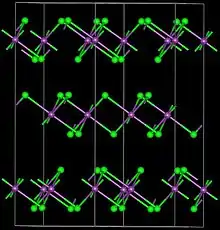Yttrium(III) bromide
Yttrium(III) bromide is an inorganic compound with the chemical formula YBr3. It is a white solid. Anhydrous yttrium(III) bromide can be produced by reacting yttrium oxide or yttrium(III) bromide hydrate and ammonium bromide. The reaction proceeds via the intermediate (NH4)3YBr6.[3] Another method is to react yttrium carbide (YC2) and elemental bromine.[4] Yttrium(III) bromide can be reduced by yttrium metal to YBr or Y2Br3.[5] It can react with osmium to produce Y4Br4Os.[6]
 | |
| Names | |
|---|---|
| IUPAC name
Yttrium(III) bromide | |
| Other names
Yttrium tribromide | |
| Identifiers | |
3D model (JSmol) |
|
| ChemSpider | |
| ECHA InfoCard | 100.033.375 |
| EC Number |
|
PubChem CID |
|
| UNII | |
CompTox Dashboard (EPA) |
|
| |
| |
| Properties | |
| YBr3 | |
| Molar mass | 328.618 g/mol |
| Appearance | colorless hygroscopic crystals |
| Melting point | 904 °C (1,659 °F; 1,177 K) |
| 83.3 g/100 mL at 30°C | |
| Structure | |
| Trigonal, hR24 | |
| R-3, No. 148 | |
| Hazards | |
EU classification (DSD) (outdated) |
|
| NFPA 704 (fire diamond) | |
Except where otherwise noted, data are given for materials in their standard state (at 25 °C [77 °F], 100 kPa). | |
| Infobox references | |
References
- Lide, David R. (1998), Handbook of Chemistry and Physics (87 ed.), Boca Raton, Florida: CRC Press, pp. 4–94, ISBN 0-8493-0594-2
- http://www.sigmaaldrich.com/catalog/product/aldrich/451355?lang=en®ion=US
- Gerd Meyer, Siegfried Dötsch, Thomas Staffel (1987). "The ammonium-bromide route to anhydrous rare earth bromides MBr3". Journal of the Less Common Metals. 127: 155–160. doi:10.1016/0022-5088(87)90372-9.CS1 maint: multiple names: authors list (link)
- Mussler, R. E.; Campbell, T. T.; Block, F. E.; Robidart, G. B. Metallothermic reduction of yttrium halides. Bureau of Mines Report of Investigations, 1963. 6259. pp 21.
- H. Mattausch, J. B. Hendricks, R. Eger, J. D. Corbett, A. Simon (1980). "Reduced halides of yttrium with strong metal-metal bonding: yttrium monochloride, monobromide, sesquichloride, and sesquibromide". Inorganic Chemistry. 19 (7): 2128–2132. doi:10.1021/ic50209a057. ISSN 0020-1669.CS1 maint: multiple names: authors list (link)
- Peter K. Dorhout, John D. Corbett (1992). "A novel structure type in reduced rare-earth metal halides. One-dimensional confacial chains based on centered square antiprismatic metal units: Y4Br4Os and Er4Br4Os". Journal of the American Chemical Society. 114 (5): 1697–1701. doi:10.1021/ja00031a024. ISSN 0002-7863.
This article is issued from Wikipedia. The text is licensed under Creative Commons - Attribution - Sharealike. Additional terms may apply for the media files.
